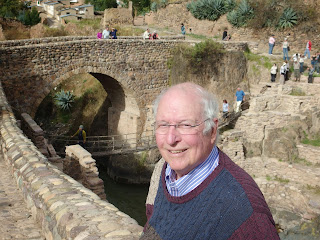On Thursday, May 14, we left Puno for Cusco on the Inka Express, a ten hour 220 mile guided tour aboard a comfortable bus. We made several stops including a buffet lunch stop. We drove through Juliaca where the local airport is, and the guide pointed out the unfinished buildings (they leave them that way to pay less in property tax) and the "unofficial" gas stations featuring untaxed gas smuggled in from Bolivia with the help of bribes to the border guards and police.
Our first stop was the town of Pucara. The town is famous for its production of ceramic bulls, which decorate the roofs of many buildings around Cusco. The bulls are supposed to be displayed in pairs (supposedly male and
female?) to ensure fertility of the land.
 |
| Bulls Guarding the Local Church |
A wedding was taking place in the village church. During the service a group we'd call a
Mariachi band arrived, entered the church, and accompanied their female soloist in some romantic music. As we were leaving the town, we saw the band leading the bride and groom and the guests into the plaza in front of the church.
The highest elevation of the trip was at the La Raya Pass, at 14,235 feet. The pass marks the line between the departments of Puno and Cusco and is the point of origin for the Urubamba River, formed by water melting down from the Andes Range. The Urubamba runs north through the Sacred Valley and past Machu Picchu until it joins two other rivers to form the Amazon. Once over the pass, the landscape became much greener, with richer agricultural land, and the villages appeared much more prosperous.
The ruins of the Temple of Virachocha at the town of Raqchi were our next stop. This was one of the holiest shrines of the Inca empire. Twenty-two columns made of huge stones helped support the largest-known Inca roof. The Spanish destroyed most of the temple, but the ruins, with some reconstruction, remain.
 |
| The Temple of Viracocha |
 |
| An Inca Trail. The Incas Built a Network of Trails from as Far North as Ecuador and as Far South as Northern Chile. The Spanish Invadors Used this Network in Conquering Much of the Territory |
 |
| A Water Duct, Used to Irrigate the Surrounding Fields |
|
The bus stopped to allow people to cross a reproduction of an Inca suspension bridge. We watched but opted out of participation.
After lunch we stopped to view the churches at a couple of colonial villages, Andahuaylillas and San Sebastian. Neither of these baroque chapels allowed photography inside their heavily embellished sanctuaries. The first Iglesia de San Pedro, is known as the "Sistine Chapel of the Andes" - very interesting paintings cover much of the surface, but not quite Michelangelo.
 |
| The "Sistine Chapel of the Andes" |
 |
| I Sneaked a Photo, then Nick Pointed Out the Security Cameras and Monitor |
 |
| Exterior of Church at San Sebastian |
We arrived in Cusco about 6 PM and were delivered to our hotel for an early night, leaving for Machu Picchu the next day.











No comments:
Post a Comment